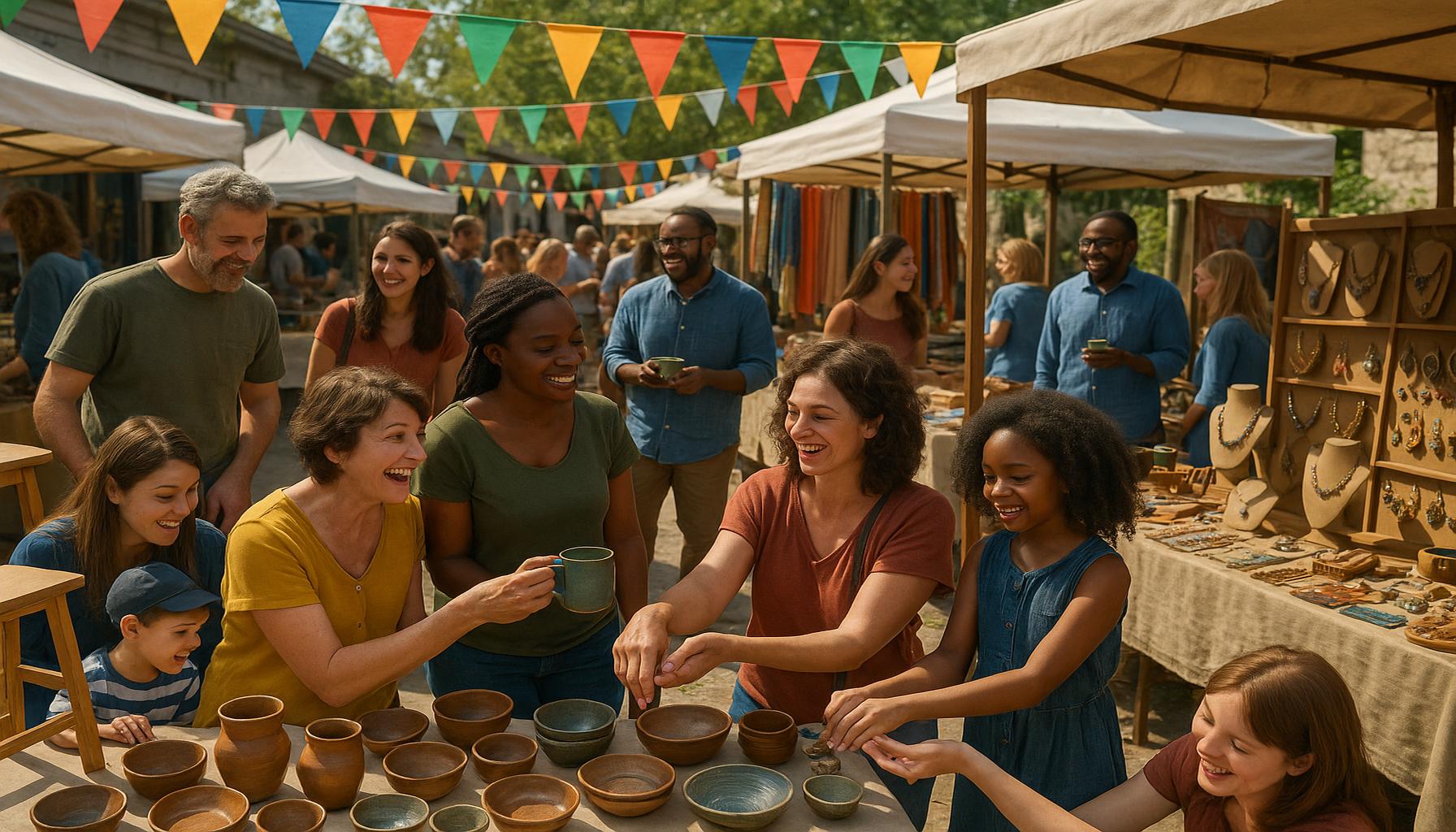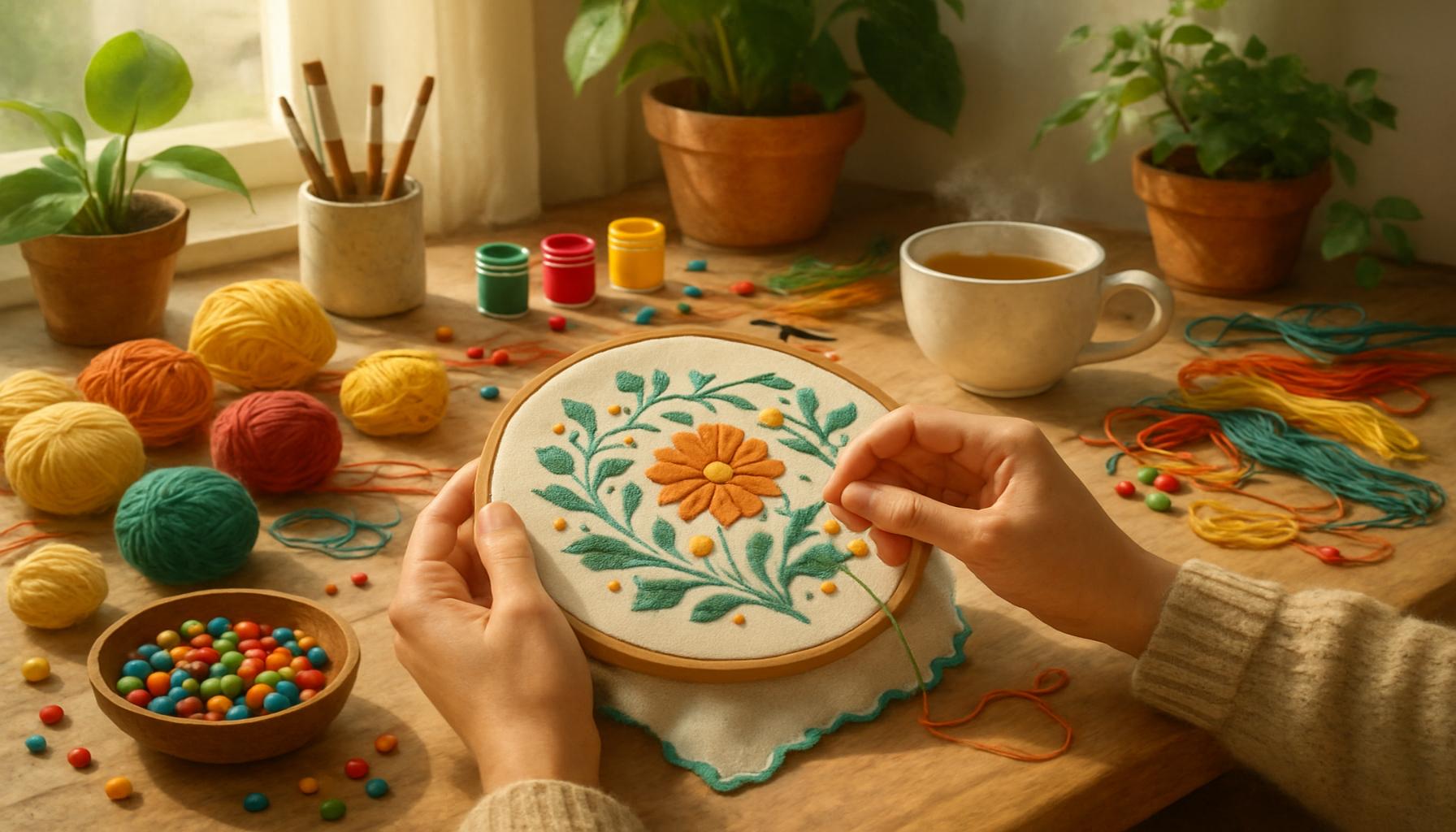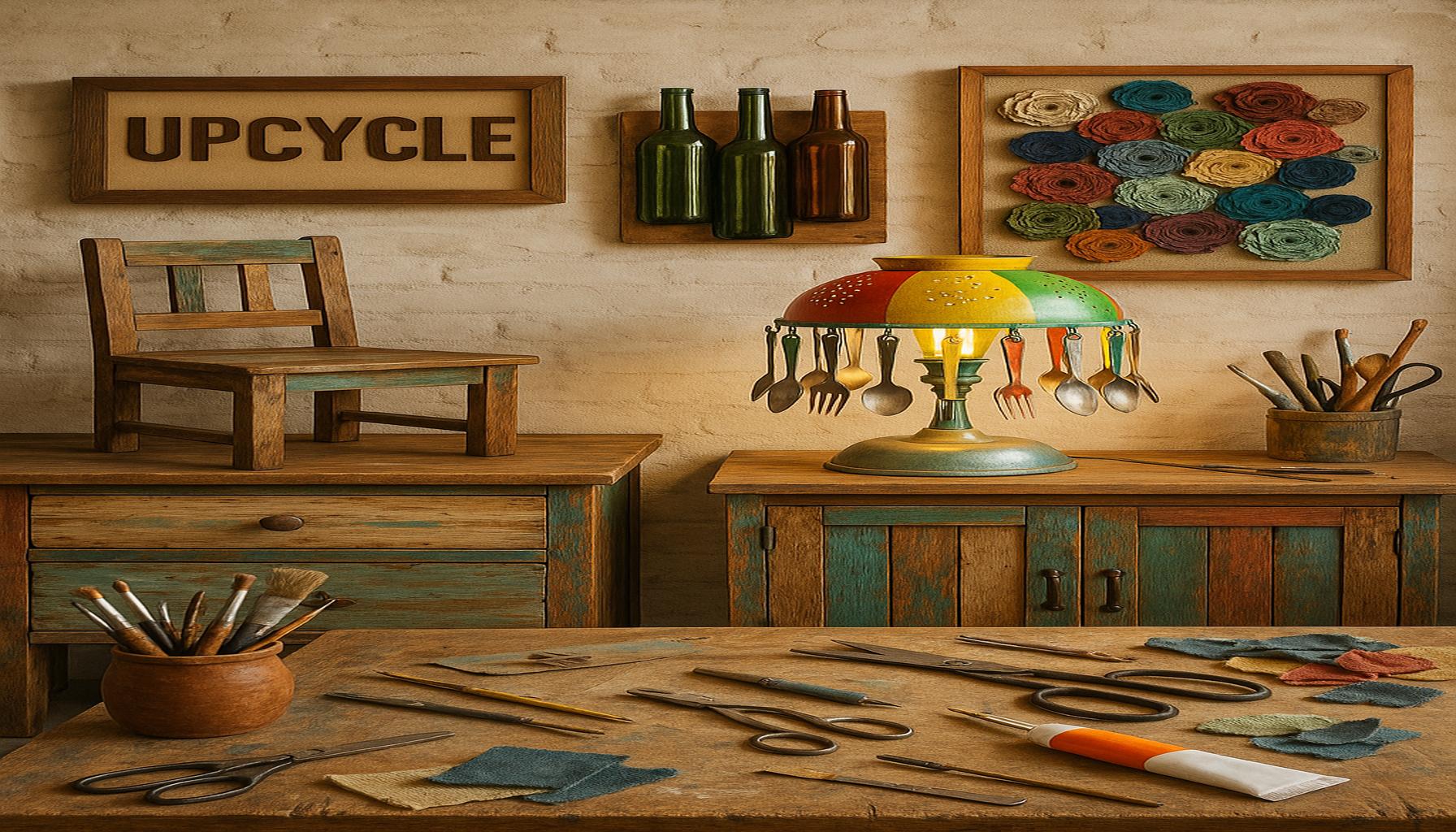The Influence of Colors in Handicrafts: How to Choose Palettes that Inspire and Transform
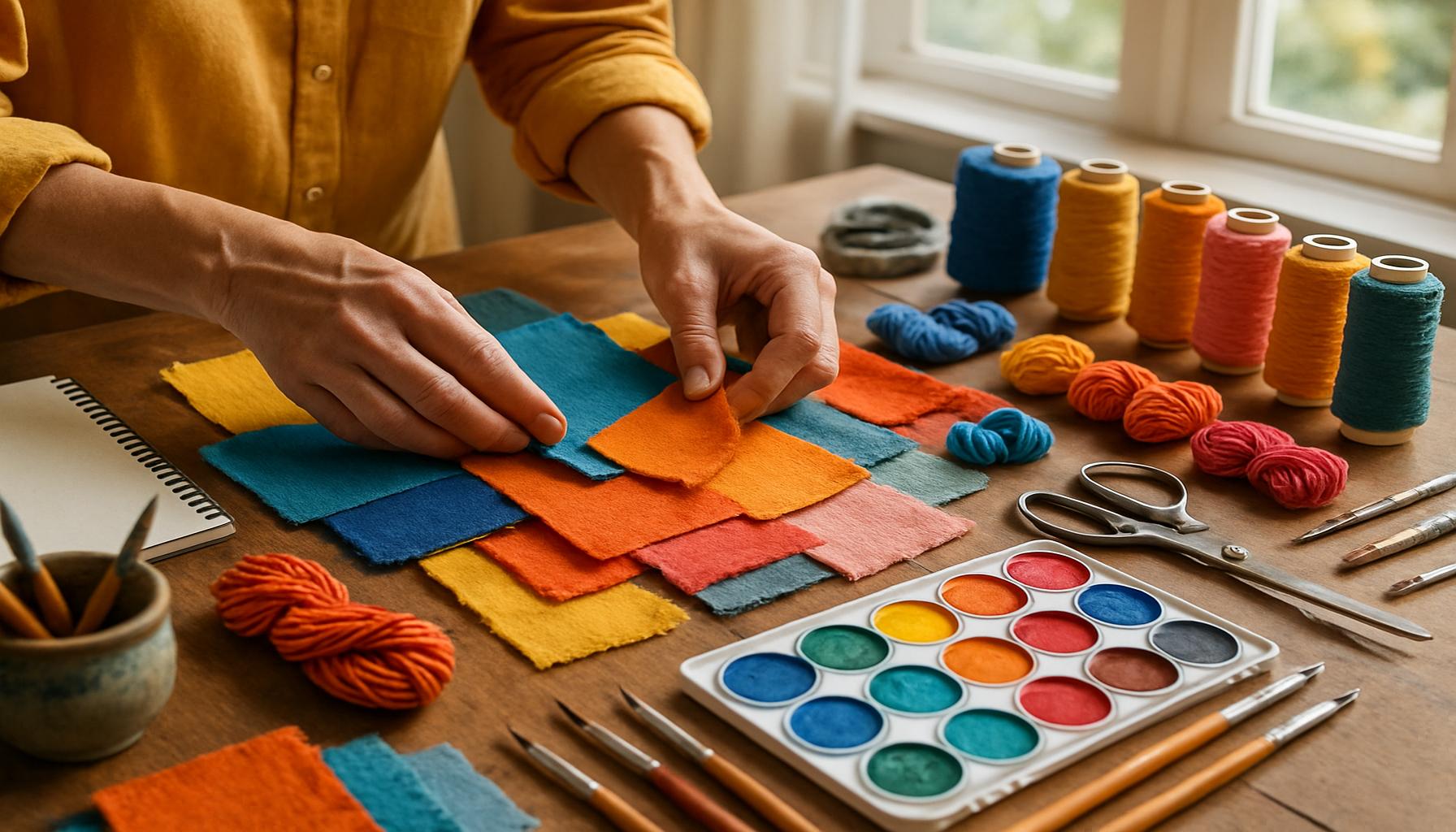
The Power of Color in Handicrafts
The world of handicrafts is a canvas of creativity, where colors play a pivotal role in shaping the final product. Colors can evoke emotions, tell stories, and even influence the mood of a space. Understanding the psychology of colors is essential for artisans who aspire to make their work resonate deeply with their audience. Whether it’s the vibrant hues found in Native American beadwork or the soft pastels often seen in Shaker furniture, color choices are integral to the storytelling of each artisan’s work.
Choosing the right color palette can:
- Enhance aesthetic appeal: Harmonious colors can attract attention and invite admiration. For example, a handcrafted vase that incorporates complementary colors can evoke a sense of balance, drawing visitors’ eyes and enhancing the overall experience of a room.
- Communicate themes: Certain colors signify different emotions and messages, enriching the narrative of the artwork. The use of green may convey growth and renewal, while black can indicate sophistication or mourning. By intentionally selecting colors, artisans can deepen the narrative embedded within their pieces.
- Define cultural connections: Color choices can reflect cultural heritage, adding authenticity to handicrafts. For instance, traditional African textiles often showcase bold, vibrant colors that symbolize different aspects of life and spirituality, linking each piece to the rich tapestry of culture from which it originates.
By exploring the influence of colors, artisans can unlock the potential of their creations. For instance, warm colors like reds and oranges can create a sense of warmth and invitation, making a space feel cozier and more welcoming. Conversely, cool colors like blues and greens evoke calmness and tranquility, serving as a perfect backdrop for meditation or relaxation. As you delve into this vibrant world, consider how your palette choices can inspire and transform not only your work but also the lives of those who experience it.
In this article, we will uncover tips on selecting color palettes that not only captivate but also enhance your handcrafting journey. Explore combinations like analogous colors, which sit next to each other on the color wheel, fostering a serene feel, or triadic palettes, which use three evenly spaced colors to create dynamic contrast. Each choice carries significance and can greatly influence the viewer’s experience.
Join us as we explore the intersection of creativity, culture, and color! The nuances of color use in handicrafts invite artisans and observers alike to reflect on personal experiences, cultural significance, and emotional connections. With an understanding of these elements, you can create works that resonate on multiple levels and inspire others in profound ways.

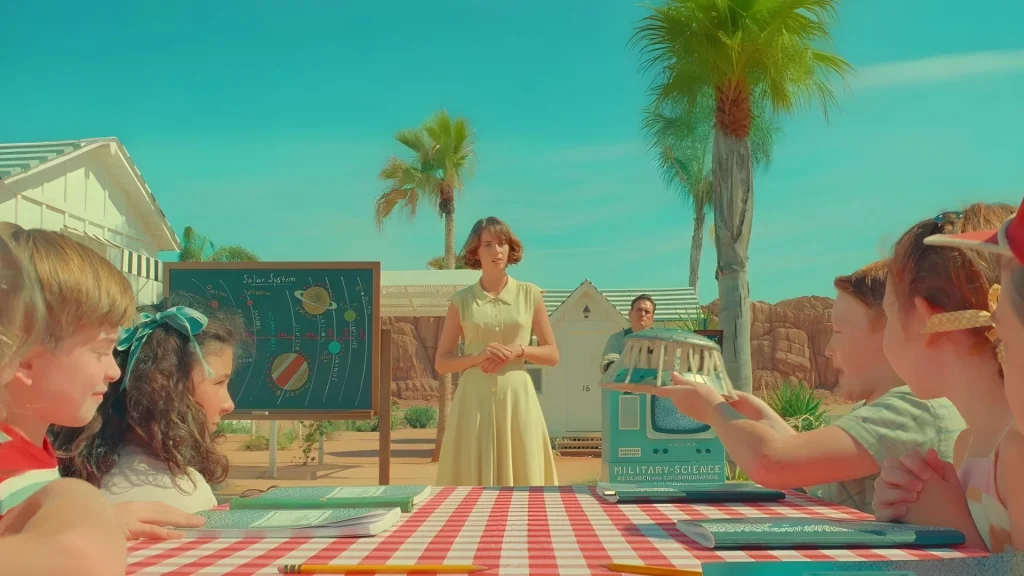
DIVE DEEPER: Click here to discover the art of street photography
Understanding Color Theory in Handicrafts
In the realm of handicrafts, color theory serves as a guiding principle for artisans seeking to elevate their creations. At its core, color theory is the body of practical guidance to color mixing and the visual effects of color combinations. It encompasses concepts ranging from the color wheel to the emotional resonance of various shades, facilitating a deeper understanding of how color can be applied to crafting
Understanding the color wheel is an essential first step for artisans. Divided into primary, secondary, and tertiary colors, this tool provides a foundation for creating visually appealing palettes. Primary colors—red, blue, and yellow—cannot be created by mixing other colors. Secondary colors, on the other hand, arise from mixing primary colors, producing green, orange, and purple. Tertiary colors come from the blending of primary and secondary colors, resulting in a variety of nuanced shades.
These foundational aspects of color theory can translate into various creative strategies, presenting artisans with a spectrum of options when selecting their palettes. Here are a few color combinations that can lead to stunning results:
- Complementary Colors: Colors that sit opposite each other on the color wheel, such as blue and orange, create striking contrasts and draw the viewer’s attention. This technique is perfect for highlighting specific features in a piece.
- Analogous Colors: These colors lie next to each other on the wheel, like red, red-orange, and orange, producing harmonious and serene looks. Ideal for creating more cohesive designs, analogous colors evoke a sense of calm and unity.
- Triadic Colors: Utilizing three colors evenly spaced on the color wheel, such as red, yellow, and blue, presents dynamic contrast and vibrant energy. This approach can infuse life into artisanal creations, drawing viewers in with its lively balance.
Additionally, the psychological implications of color must not be overlooked. Colors wield the power to fundamentally shift moods and perceptions. For instance, studies reveal that yellow can instill feelings of happiness and energy, while blue often induces relaxation and tranquility. Such insights empower artisans to select colors that align with the emotional intentions behind their work.
Moreover, in a marketplace influenced by trends and consumer preferences, artisans can find inspiration in the latest color forecasts. Experts in design and fashion routinely predict color trends that reflect the cultural zeitgeist. For example, the Pantone Color Institute annually announces its ‘Color of the Year,’ which has the potential to sway artisan color choices for years to come. By staying attuned to these shifts, artists can ensure their creations resonate deeply with current audiences, creating works that not only attract but also connect.
As artisans explore their unique style through color palettes, they open themselves up to a world of creativity that can profoundly impact not just their work but also the experiences of those who engage with it. Understanding the nuances of color selection can empower artisans to craft pieces that not only capture visual beauty, but also tell compelling stories and foster emotional connections.
When exploring the influence of colors in handicrafts, it’s essential to understand not only the emotional and psychological impact of colors but also the practical aspects of choosing palettes that resonate with both creators and consumers. Color selection can profoundly affect the perception of handmade items, serving as an essential aspect of design that can either attract or repel potential buyers. Colors evoke emotions and convey messages; for instance, warm shades like red and orange may stimulate energy and enthusiasm, making them perfect for vibrant home decor. Conversely, cool tones like blue and green are often associated with tranquility and harmony, ideal for soothing environments or personal crafts that promote relaxation, such as pottery or textiles. Furthermore, understanding color theory, particularly the relationships within the color wheel, can aid artisans in selecting complementary hues that enhance their work. Colors that are situated opposite on the wheel, known as complementary colors, can create striking contrasts that captivate attention. Consideration of seasonal color trends can also guide artisans in offering pieces that align with current consumer preferences.Additionally, the cultural significance of colors cannot be ignored. Different cultures assign varied meanings to colors; for example, red may symbolize luck and prosperity in Chinese culture, while it represents passion in Western contexts. Integrating culturally significant colors into handicrafts can resonate more deeply with specific audiences, fostering a stronger connection between the artist and the consumer.Choosing the right palette is not merely a decision about aesthetics but a strategic choice that can enhance the value and appeal of handmade items in a saturated market. Handicrafters must be aware of trends but should also stay true to their artistic voice, ensuring that their selections promote authenticity and originality. By delving into the psychology, theory, and cultural contexts of color, creators can significantly amplify the impact of their handicrafts, inspiring and transforming their audience. Engaging storytelling through color not only enhances the product’s attractiveness but helps narrate the essence behind the creation, inviting consumers into the artist’s world. This rich interplay between craft and color ultimately shapes the narrative of the piece, allowing for a deeper emotional interaction between the artisan and their audience.
DIVE DEEPER: Click here to discover how music can enhance your creativity
Emotional and Cultural Resonance of Colors
Beyond the technical aspects of color theory lies an intriguing realm of emotional and cultural resonance. Colors are not merely visual elements but are imbued with meaning—often deeply rooted in individual experiences and cultural contexts. For artisans, understanding these dimensions can enhance the emotional depth of their work, elevating it from a simple craft to a profound expression of identity and narrative.
Take, for instance, the color red. In Western cultures, red generally symbolizes love and passion, evoking strong feelings and often being a popular choice for festive occasions. However, in numerous Asian cultures, such as Chinese, red is embraced as a symbol of happiness, good fortune, and celebration. When artisans select red for their projects, they wield its power differently, aligning it with the narratives they wish to convey and the emotions they want to elicit from their audience.
Cultural influences extend to color palettes as well. Different cultures have distinct associations with color combinations. For example, the vibrant colors of Latin American handicrafts often embody a celebration of life and nature, drawing upon bright yellows, greens, and pinks that evoke the landscapes and traditions of the region. In contrast, Scandinavian design favors a more muted palette, favoring softer grays, blues, and whites that reflect the minimalist aesthetic and natural surroundings. By respecting and incorporating these cultural contexts, artisans can create pieces that resonate more deeply with their audience, offering a sense of familiarity and connection.
Seasonal Influences on Color Selection
Another layer to consider when selecting color palettes is the impact of seasonal influences. The changing seasons often inspire distinct color trends, leading artisans to adapt their creations to align with these natural cycles. For instance, spring often brings a resurgence of pastel colors like baby blue, soft pink, and pale yellow, symbolizing renewal and rebirth. Conversely, autumn ushers in earthy tones such as burnt orange, deep red, and rich brown, reflecting the harvest and the warming of trees.
Leveraging seasonal palettes not only keeps artisans relevant within market trends but also invites consumers to engage with the changing landscape around them. Consider how handmade items for the holidays often incorporate rich jewel tones and metallics, creating a sense of warmth and festivity that mirrors the feelings of the season. Artisans can capitalize on this connection by creating limited-edition pieces that align with seasonal themes, expanding their market appeal and enriching the consumer experience.
Experimenting with Color Through Mixed Media
The exploration of color palettes becomes even more exciting when artisans delve into the world of mixed media. Combining different materials, textures, and colors can yield unexpected results and broaden the artistic expression. For example, wood, fabric, and metal can be used in tandem, allowing artisans to explore color variations across different materials. A deep blue fabric can pair beautifully with a natural wood finish, offering a contrast that draws the eye and enhances the overall design.
Moreover, experimenting with unconventional color sources, such as natural dyes derived from plants or herbal mixtures, can elevate the uniqueness of a handcrafted product. The use of these dyes not only offers artisans a vast array of color options but also aligns with eco-friendly practices that are increasingly important to today’s consumers.
Ultimately, the world of color in handicrafts is a rich and dynamic landscape where emotional resonance, cultural significance, and creative experimentation intersect. By understanding and applying these principles, artisans can inspire and transform their work into something unforgettable, capturing both the imagination and the hearts of those who encounter it.
DISCOVER MORE: Click here to learn how creative hobbies can enhance your mental well-being
Bringing Colors to Life: Final Thoughts
In conclusion, the world of handicrafts offers an extraordinary opportunity for artisans to explore the transformative power of colors. From the emotional and cultural contexts imbued in each hue to the seasonal influences that dictate color trends, there is an endless canvas for creativity and expression. By understanding the significance behind different colors and embracing the nuances of their meanings, artisans can create works that resonate deeply with their audience and evoke genuine responses.
The incorporation of diverse color palettes, whether through traditional combinations or more experimental approaches using mixed media and natural dyes, allows for not only aesthetic appeal but also a narrative richness that elevates handcrafted items above mere commodities. Artisans who take the time to study their audiences and reflect upon their cultural backgrounds can connect more profoundly, fostering a sense of identity and shared experience.
As you embark on your own journey into the world of colors in handicrafts, consider the many layers at play: the stories that colors tell, the emotions they evoke, and the cultural foundations that shape our perceptions. By harnessing this knowledge, you can transform your creations into powerful expressions that inspire and captivate. Dive into the realm of colors, experiment boldly, and let your handicrafts reflect the beauty of the world around you.
